Pōhutukawa flowers
One of the great indigenous trees on the northern half of New Zealand’s North Island—it’s often planted elsewhere as well—is Metrosideros excelsa. The Māori* gave it the name pōhutukawa, which English speakers later adopted (though I heard some of them shorten it to what sounded to me more like putukawa). There’s also a tradition of referring to the pōhutukawa as the New Zealand Christmas tree because of the many clusters of red flowers it puts out in December. I arrived on February 3 and therefore missed that holiday display, but on the next day, in the town of Waiwera north of Auckland, I managed to find exactly one pōhutukawa tree that still had some flowers on it.** The sky was overcast and a fine drizzle was coming down, but I did what I could to take some pictures. It’s good that I did, because I didn’t find any more of these trees flowering during my 3+ weeks in New Zealand.
—–
* A bar (technically called a macron) over a vowel indicates that the vowel is to be pronounced for a longer time than regular vowels. Many languages (but not English) make a distinction between long vowels and regular vowels, so that mā (if such existed) would be a different word from ma and have a different meaning.
Also like many languages, Māori has five vowels, whose pronunciations I’ll spell out as we might write them in English: a (ah), e (eh), i (ee), o (oh), u (oo). In effect, Māori has the same five vowels as Spanish.
—–
** At least I’m hoping this is a pōhutukawa and not one of the rātā that are its later-flowering genus-mates.
© 2015 Steven Schwartzman

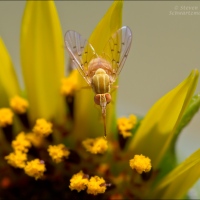
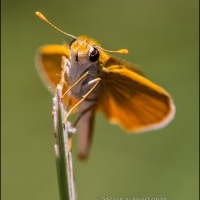
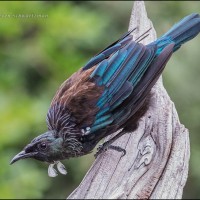
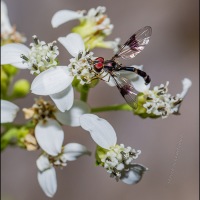
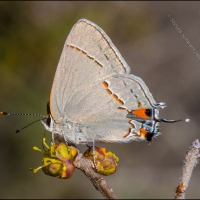
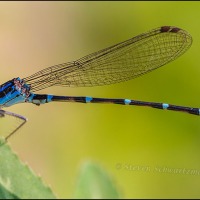

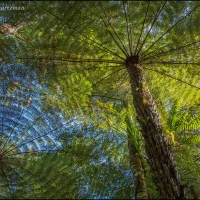
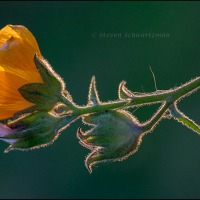
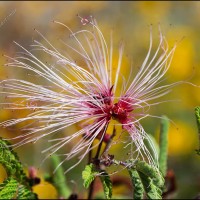
Amazing that your first photo of a New Zealand native should remind me of a Texas native: the sensitive briar. It looks like a single filament remains as the flower fades, like a honeysuckle. Even if conditions weren’t perfect, I’m glad you were able to photograph its blooms — it’s lovely.
shoreacres
March 11, 2015 at 7:34 AM
Interesting that the mighty pōhutukawa tree should remind you of the lowly sensitive briar, but our associations are what they are.
One disadvantage for me of having been in a strange land so briefly is that I didn’t have time to get familiar with the things I photographed. To the point, I can’t confirm or deny (now I sound like a government spokesman) your notion that a single filament remains as a pōhutukawa flower fades. It’s plausible, but I wonder if that could be the opening stage of the flower rather than its fading stage. Maybe a botanically minded New Zealander will come to our rescue.
Steve Schwartzman
March 11, 2015 at 8:27 AM
Check out page 691 of this article. This is way above my pay grade, but I do think that the answer is in the chart and the related text.
shoreacres
March 11, 2015 at 8:36 AM
Bingo for you: the style persists at the end. Thanks for looking it up, and so quickly.
Steve Schwartzman
March 11, 2015 at 8:40 AM
You must have loved this~new plants, and a new language to play with.
melissabluefineart
March 11, 2015 at 8:31 AM
I did. I dealt more with the plants (and the landscapes), but naturally I was curious about the native language too, even if I didn’t often hear it spoken. New Zealand television has a Māori channel that I tuned to a few times (there are English subtitles). I amused myself when I was in the art museum in Wellington by looking at the bilingual plaques accompanying paintings to see how Māori, with its small inventory of consonants, transliterates the names of foreign countries from English. For example, England comes out as Ingarangi, and Ireland as Airangi.
Steve Schwartzman
March 11, 2015 at 8:52 AM
I read somewhere that languages everywhere share certain basic “rules”, even when the people have always been isolated from other civilizations. I find that fascinating.
melissabluefineart
March 11, 2015 at 9:01 AM
Most linguists believe that the human brain is “hard-wired” for language and that there are common underlying linguistic structures. How those “deep structures” ultimately get expressed can differ a lot from one language to another. It’s also interesting that there are various processes that might seem plausible but that no language uses. For example, no language takes a long statement and makes a question out of it by saying all the words in reverse order (though we can make a question by flipping a couple of key words: “He is the best singer of his era” becomes the question “Is he the best-selling singer of his era?” rather than “Era his of singer best the is he?”)
Steve Schwartzman
March 11, 2015 at 9:17 AM
Yes, I’ve read that. Very interesting.
melissabluefineart
March 12, 2015 at 7:14 AM
Agreed. Sounds like you’ve done your share of reading about language.
Steve Schwartzman
March 12, 2015 at 8:36 AM
the image did not load, so for now my imagination is painting several options as to what this looks like! will be back when using faster internet! z
Playamart - Zeebra Designs
March 11, 2015 at 8:38 AM
Good for you for turning an obstacle (the failure of the image to load) into a spur to your imagination. As Shakespeare noted: Sweet are the uses of adversity.
Steve Schwartzman
March 11, 2015 at 8:53 AM
I believe your tentative ID is correct, but I’ve sent a link to your post to a dear friend in Whanganui who is not only also a veterinarian but also a serious conservationist and asked him to confirm. I’ll let you know as soon as I hear back from him. Either way, you were very fortunate to find this one in full flower!
krikitarts
March 11, 2015 at 10:34 AM
Thanks for checking with your friend. What I’m pretty certain of here is that I photographed some native tree. I’m still hopeful that it was a pōhutukawa.
Steve Schwartzman
March 11, 2015 at 10:46 AM
Great photo. You should have come down to Napier/Hastings. We had a lot of flowering Pohutukawa, even at that time. Next time.
Raewyn's Photos
March 11, 2015 at 1:03 PM
Thanks, Raewyn. I wanted to see Napier but the closest I got was Taupo. So much to see, so little time.
Steve Schwartzman
March 11, 2015 at 2:36 PM
Just beautiful! Feast for the eyes!
Dianne
March 11, 2015 at 2:30 PM
That’s how I felt, Dianne. Too bad I didn’t end up seeing more of these flowers.
Steve Schwartzman
March 11, 2015 at 2:59 PM
They are such a lovely sight en masse – I loved the tight buds with a hint of red before the pom-poms burst out 😀
https://smallbluegreenflowers.wordpress.com/2014/12/08/new-zealand-pohutukawa-tree/
Heyjude
March 11, 2015 at 4:47 PM
It’s good to hear from someone who’s experienced them, and in greater quantity than I did.
Steve Schwartzman
March 11, 2015 at 5:46 PM
Very pretty – reminds me a little of the Bottle Brush plant
norasphotos4u
March 11, 2015 at 5:06 PM
Bottle brush plants are native to Australia, which isn’t so far away from New Zealand. They’re also in the same botanical family, the Myrtaceae, as the pōhutukawa, so the resemblance is more than coincidental.
Steve Schwartzman
March 11, 2015 at 6:49 PM
Cool – so I wasn’t too far off base on this 🙂
norasphotos4u
March 12, 2015 at 6:02 AM
No, you were on target.
Steve Schwartzman
March 12, 2015 at 8:35 AM
I’ll join the others who mentioned an impression of something similar and say that my first impression was that of a flower amongst reindeer lichen.
Steve Gingold
March 11, 2015 at 6:12 PM
I think you get the prize for imagination on this one, Steve. I looked up reindeer lichen to remind myself what it looks like.
Steve Schwartzman
March 11, 2015 at 6:52 PM
This is wonderful.. i had no idea you were out home.. I am excited to read your impressions.. c
Cecilia Mary Gunther
March 11, 2015 at 7:38 PM
I like the way you put that: “out home.” Yes, it was a wonderful trip, and I’m happily sharing impressions, both visually and verbally.
Steve Schwartzman
March 11, 2015 at 9:12 PM
Beautiful flowers.
roamingpursuits
March 11, 2015 at 10:29 PM
I hope you’ll get to roam over and see some of them.
Steve Schwartzman
March 12, 2015 at 8:29 AM
This resident New Zealander is very pleased to see your beautiful photograph. I am glad you enjoyed your connection with the language as well as the flowers.
Gallivanta
March 12, 2015 at 3:23 AM
Thank you, resident New Zealander and hostess. Given the limited time, my connection with nature there was much more than with the language.
Steve Schwartzman
March 12, 2015 at 8:34 AM
I think some would say that the language and nature of New Zealand are very closely bound.
Gallivanta
March 12, 2015 at 7:20 PM
You make a good point. Certainly the native names for things have been much on my mind as I’ve sorted through pictures from the trip.
Steve Schwartzman
March 12, 2015 at 8:03 PM
So gorgeous and interesting, such a wonderful treat on this cold, gray, spring morning.
Charlie@Seattle Trekker
March 12, 2015 at 9:07 AM
It was cool and grey (and drizzling) there when I took this picture, but the colors and shapes compensated for the weather.
Steve Schwartzman
March 12, 2015 at 9:15 AM
You must have been elated to find a “New Zealand Christmas tree” in February. Besides their attractive color, I like the flowers’ feathery aspect.
tanjabrittonwriter
August 29, 2023 at 7:23 PM
Mostly I was sorry that by February we’d missed the great display of these trees that takes place a month or two earlier. The little bit shown flowering here was all we could manage to find in February.
Steve Schwartzman
August 29, 2023 at 9:41 PM
Maybe you need to return there in December!
tanjabrittonwriter
August 29, 2023 at 9:43 PM
I thought about it. Given all the scenic places in the world that I’ve never been to, some of those would likely take precedence.
Steve Schwartzman
August 30, 2023 at 5:58 AM
The fact that there is an actual idiom for having too many choices tells something of the associated difficulties in making decisions, though it’s interesting to compare the expressions in different languages. For French and English speakers, “embarras of choix” and “to be spoilt for choice” don’t seem to connote any pain, as opposed to the German “die Qual der Wahl.”
I hope that choosing your next travel destination won’t be painful for you.
tanjabrittonwriter
August 31, 2023 at 7:59 AM
That’s a pithy (and rhyming) German proverb. Qual is a new word for me. I wondered if it might be a cognate of the English verb quail, meaning ‘to cower, shrink back in fear,’ and sure enough the American Heritage Dictionary says the English word probably comes from Middle Dutch quelen, which meant ‘to suffer, be ill.’
Steve Schwartzman
August 31, 2023 at 8:11 AM
As for Wahl, I know it as the name of a company that makes grooming products. Now I also know it means ‘choice.’
Steve Schwartzman
August 31, 2023 at 8:14 AM